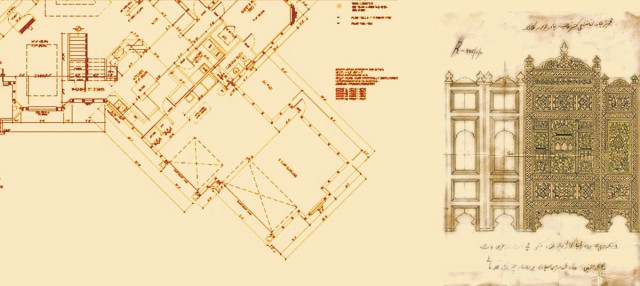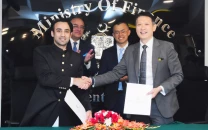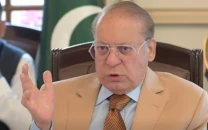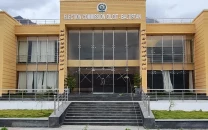The homecoming
I was born into one of those families that presumes one completes their studies at a Western university.

Willie G had quite a few Pakistani residents and we forged the type of deep friendships one forges when they live thousands of miles from home. It was when I was in Willie G that I met and became friends with Martand, from Delhi, who was studying to become an architect. At the time, I had never been to India. I had no notion of what India was like or what Indians were like other than the opinions I’d picked up in school textbooks, novels, television, the press, movies. You get the picture.
Martand and I hit it off immediately. South Asia being a much smaller place than you’d think, we had been paying guests at different times in the same apartment in Queensway. His maternal grandfather, Bisham Sahni, the great Hindi writer, was a contemporary of Faiz Ahmed Faiz, the legendary Pakistani poet. I learnt that both his grandparents and my father shared the same alma matter, Lahore’s famous Government College. I learnt that part of Martand’s family were from Lahore, and had been forced to flee to India during Partition. I’ve always been a proud Lahori, a vekhiya tay jamiya nahin (if you ain’t seen it, you ain’t seen nothin’) sort, and his connections with the city of my birth, along with his wit and intelligence and the fact that my girlfriend got along with him, made my relationship with Martand stronger.
Still, it was a shock when, one evening Martand barged into my room at Willie G and said, in mock outrage “Oi b*** ch*d, you’re living in my f***ing house!”
Mr and Mrs Mehmood Alam, my paternal grandparents, shifted to Lahore at Partition. Mehmood Alam was quite the tennis player in his day, and has the distinction of being the only person to have played Wimbledon as an Indian (1938, where he lost in a qualifying round) and as a Pakistani (1948,where he qualified but didn’t get much further than that). I mention the tennis because it was his dexterity with the racquet that got him a job at Bird & Co., India’s largest trading house at the time. During the build-up to Partition, the company decided to send Mehmood Alam, who was a manager at the firm’s Delhi operations, to Lahore. Mobs were setting about Muslims in Delhi. Best to have a Muslim manager for Muslim Pakistan’s Lahore, they must have thought. Prudent.
The Alam’s initial stay in Lahore was brief. Within a few months of being transferred, my grandfather was hired by the Associated Cement Company (Bird & Co. did the marketing for ACC), and was sent for training to Bombay. It wasn’t until 1953 the couple returned to the city they have lived in since.
The move wasn’t easy. Families that had opted to migrate to Pakistan were compensated, if that is the correct term for this situation, for what they had left behind. What they were often compensated with, and this is why the word compensation isn’t quite right, was the properties millions of Hindus and Sikhs who, having found themselves overnight religious minorities in a hostile Muslim majority country, left everything in their life behind when fleeing the violence of Partition into the relative safety of India. After Partition, with the flood of mohajirs into the newly-formed Pakistan, there was a rush of compensation claims. Given that, in the words of a New Yorker of the time, the maturity of the Pakistani establishment could be likened to a gang of enthusiast novices, these compensation claims succumbed to manipulation. They became politicised and, even quicker, the source of great corruption.
For Mr and Mrs Alam — now the parents of two children with a third on the way and anxious to find a home to settle into – what all this meant was that there weren’t any good houses left to pick from.
My grandfather is one of those old school Muslim gentlemen who thought themselves modern if they didn’t insist their women cover their heads but balked at the thought of women exercising “their independence” any further. My grandmother, Surraya Alam, is one of those old school Muslim ladies who thought themselves independent if they challenged female stereotypes but would, eventually, always yield to their husband’s final opinion. A keen tennis player in her college days herself, Surrayya met Mehmood at a tennis match and, from what I gather from family lore, set her eyes firmly on him. When their affair was finally discovered by her father, Mehmood did the honourable thing and they were married. On her husband’s direction, however, Surrayya never played tennis again.
Young, athletic and beautiful, the Alams were embraced by post-Partition Lahore’s social circle. If Lahore’s social circle is small now, it must have been tiny in the early 1950s. Mehmood opted for membership of the Gymkhana after deciding that the relatively more exclusive Punjab Club’s “No Dogs or Natives” mentality wasn’t to his liking. By regularly playing at the Club’s manicured grass courts and dining and dancing in the magnificent clubhouse situated in the heart of Lawrence Gardens, Mehmood Alam rubbed shoulders with the bureaucratic and political elite. Chief Secretary and fellow tennis buff Akhtar Hussain was very helpful in arranging young Mehmood Alam a tour of the remaining houses in Lahore’s evacuee compensation pool.
The first house my grandparents toured was located near Lawrence and Mason Roads. It had somehow been occupied, in my grandmother’s words, by “people so backward that they were sitting in the living room twirling a stick tied to the fan. They didn’t know how to turn it on.” Despite having been years since Partition, the house was still “fully furnished.” My grandparents described it as surreal. There was a dinner service on the dining table and, in a study in an annex in the back, a glass of water lay on a desk as if someone had just risen to answer the phone. “I told them I didn’t want a house like this,” my grandfather told me. Now over ninety, he stiffens whenever he talks of Partition. His eyes gaze away.
Eventually it was Qurban Ali Khan, the SP Delhi before Partition and now the IG Police of the new Pakistani Punjab, who was instrumental in getting my grandparents a place they could call their own and where they could raise my family. Khan Sahib, who was later the Governor of NWFP as well as Baluchistan, had known the young Alam couple from his days in Delhi and their friendship had grown in Lahore. The house eventually found was on Mall Road, between the Canal and the Cantonment. It was part of the compensation pool but some powerful bureaucrats had set their eyes on it and were refusing to vacate it. According to family lore, and this is quite a measure of the type of officer he was, Qurban Ali Khan had to get the Chief Minister, Nawab Mumtaz Daultana, himself to arrange the eviction. This is how, after several years of living in a variety of flats, friends’ homes and rented bungalows, the Alams found themselves a home in Pakistan. According to the Record of Permanent Transfers kept by the Board of Evacuee Property, Mehmood Alam was transferred a 2½ acre plot with a large two storey bungalow in the middle of sprawling gardens located at 90 Upper Mall in November 1959.
My father, the eldest of Surrayya and Mehmood’s children, was married in the front lawn of 90 Upper Mall. So was my sister and, after I convinced my girlfriend to come to Lahore to work as a lawyer, so was I.
The house is huge; large enough to allow my grandparents and two generations of their offspring to live comfortably. In the Seventies, my grandparents constructed a block of two apartments in the back garden, which they put on rent. The flats are now occupied by my aunt, the potter Sheherzade Alam and Mehmood and Surrayya’s second child, who lives in the first-floor apartment, and by my immediate family, which lives downstairs. There was enough space left that my uncle Shaban, Mehmood and Surrayya’s youngest child, has built his home, a two storey flat, in one of the side gardens. I’ve lived at the back of the 90 Upper Mall property for the better part of my life.
When she left Lahore to spend the summer of 1947 in Simla, as the families of the judges of the Lahore High Court did every year, Shakuntala Khosla had no idea she would never see the city of her birth again. She was the daughter of Bawa Natha Singh, a canal engineer in the service of the British Raj. Having risen to the post of Chief Engineer of Canals, Bawa Natha Singh tucked into his savings and bought himself some land outside Lahore, on the other side of the Canal and near the railway track that marked the outer limits of the Lahore Cantonment.
The plot he bought was located on the Mall, around the mid-1920s, on this tract of land some five or more acres in size, Bawa Natha Singh built his family a stately home surrounded by gardens. Then, in a stroke of genius that would make him a very rich man, he constructed another six bungalows around the house and put them on rent. In 1928, Shakuntala was married to G.D. Khosla, a promising young Additional District & Sessions Judge, in her father’s newly built house.
Later, G.D. Khosla was elevated to the Lahore High Court and moved to a home in G.O.R. But G.D. Khosla was much more than a High Court judge. An eminent and distinguished jurist, he was also a prolific author, penning several books of fiction and history, most notably the Partition classic Stern Reckoning. In the summer of 1947, Inder Pal Khosla, told me, there was “talk” that there would be violence at the Partition. But the Khosla family dismissed it as nothing more than bazaar gossip. It was only as late as July that it became clear that the threat was real and they needed to make a decision fast. I don’t think anyone had any doubts which way things were going to be. G.D. Khosla and family opted for India. Shakuntala never returned to Lahore to collect her belongings. Instead, G.D. Khosla himself drove down to Lahore, rented a few trucks and, with the assistance of his friend Manzur Qadir, collected all his belongings. On the way back out of the city, G.D. Khosla stopped by 90 Upper Mall and collected some of his father-in-law’s belongings. That was the last time a member of the Bawa Natha Singh family set eyes on the house.
After Partition, Justice G.D. Khosla and his family lived in Simla, Mussorie and, finally, Chandrigarh when the High Court shifted to the new capital of Indian Punjab. G.D. Khosla eventually retired as Chief Justice of the Punjab High Court and spent the remainder of his years in Delhi’s Maharani Bagh. His youngest son, the architect Romi Khosla is my friend Martand’s father.
It was April 2000 when Romi was in London for work and came over to visit his son at William Goodenough House. Over dinner, Martand told his father how he knew someone — me — in the building who was from Lahore. Romi had actually visited 90 Upper Mall some years earlier when he had visited Lahore. He had been shown around the city of his birth and his grandfather’s house by Faiz Ahmad Faiz’s daughter, the artist Salima Hashmi. He remembers coming to 90 Upper Mall and meeting some people who lived there. “One was a potter” he told Martand. “Last name Alam or something.” The penny dropped.
I bloody live in Martand’s house.
Martand and I tell this story every time we meet people together. We’ve gotten quite good at it. Depending on how far into the night an evening has progressed, we can spend anywhere between five and 30 minutes talking about how we discovered I lived in Martand’s house. There are endless permutations to each facet of this story. “I want rent,” Martand will shout at me, right after it’s been used as an ice breaker to introduce me to new friends. I’ll throw in a flippant retort about how I’m a lawyer and will see him in court. Sometimes Martand will feign horror over how I live in a house with sprawling grounds — he’s come to visit Lahore twice, and both times enjoyed himself so much that he fell ill – when he has to face the insane property prices in Delhi.
Has the story made us better friends? Of course it has. For us, the story is interesting because of the sheer coincidence of it all. Every time we tell it, we also point out, at some level, the absurd and arbitrary nature of the result of Partition. If it weren’t for Partition, 90 Upper Mall would have remained a Khosla house, and I wouldn’t have the identity that I have.
Published in The Express Tribune, August 29th, 2010.



















COMMENTS
Comments are moderated and generally will be posted if they are on-topic and not abusive.
For more information, please see our Comments FAQ